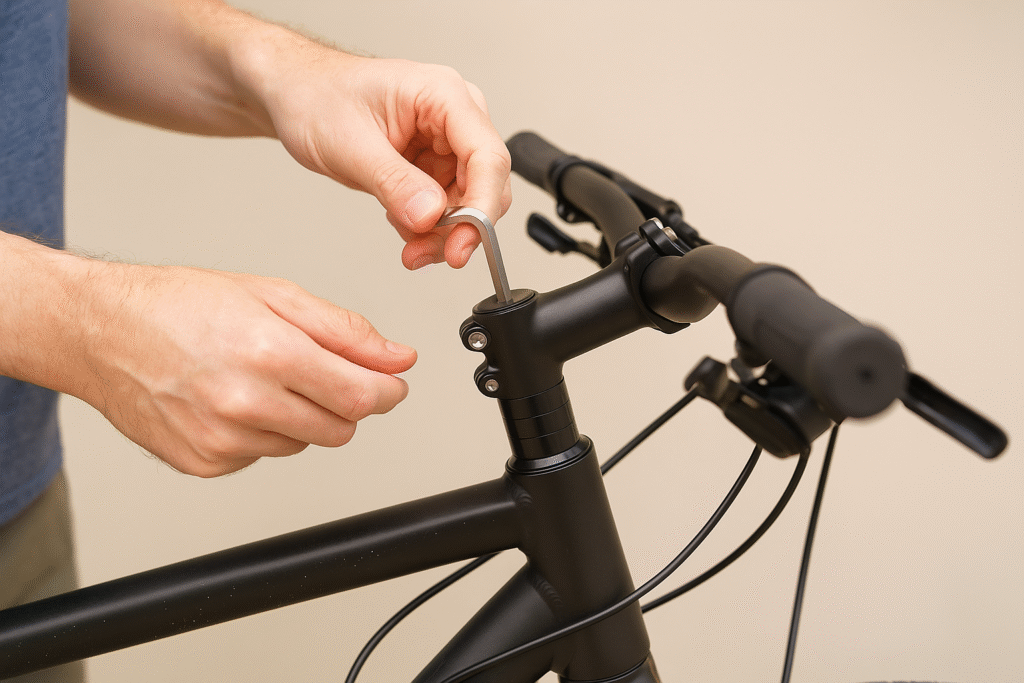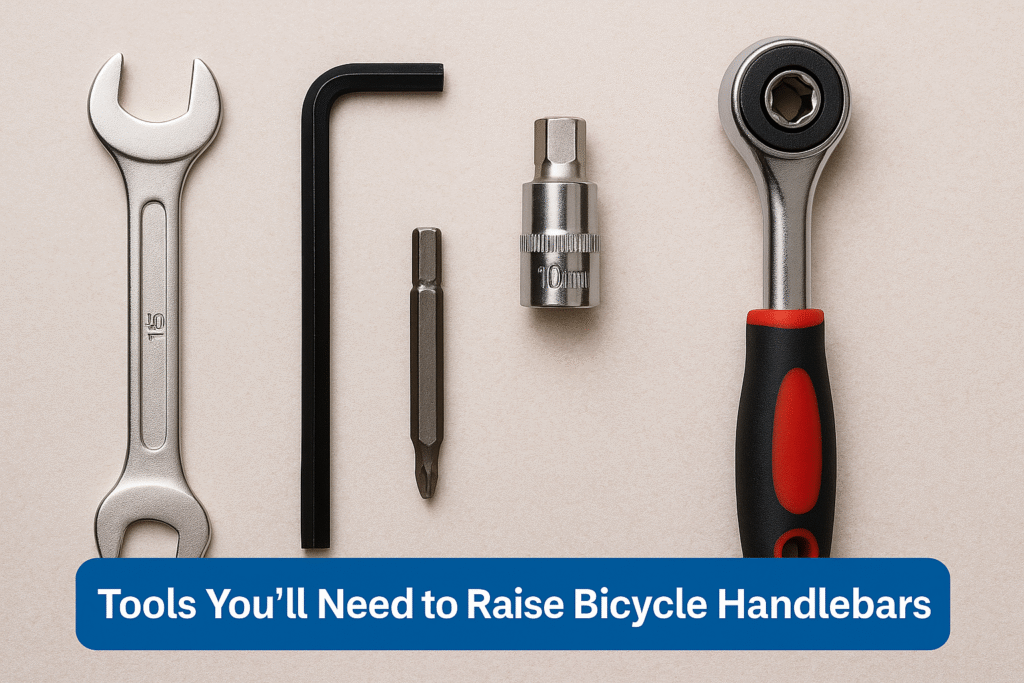1. Introduction
If you’re wondering how to raise bicycle handlebar to improve your riding posture, comfort, or control, you’re not alone. Many cyclists—from commuters to trail riders—often explore how to adjust mountain bike handlebars or how to raise handlebars on a road bike when facing wrist pain, back strain, or overall discomfort.
Your handlebar position plays a major role in how your bike feels and performs. Whether you’re seeking a more upright riding stance or experimenting with comfort handlebars for mountain bike setups, making the right adjustments can transform your riding experience. In this guide, we’ll walk you through everything you need to know about raising your handlebars—step-by-step—so you can ride farther, feel better, and stay in control.
Table of Contents

2. Why Handlebar Height Matters
- Proper handlebar height plays a critical role in maintaining a comfortable and efficient riding posture.
- A lower handlebar position may improve aerodynamics but can lead to wrist, neck, and back strain over time.
- Raising your handlebars can reduce upper body fatigue, especially on longer rides or for casual cyclists.
- Adjusting height helps tailor the bike to your body type and riding style, whether you’re on a road bike or mountain bike.
- Riders often explore how to raise bicycle handlebar to relieve discomfort and improve control during rides.
- For trail and touring cyclists, pairing the right height with swept back handlebars mountain bike setups enhances long-distance comfort.
- Commuters benefit from upright positioning, which is why learning how to raise handlebars on a road bike or hybrid is common for city riders.
- Improper handlebar height can contribute to numb hands and shoulder pain, signaling the need for an ergonomic adjustment.
3. Tools You’ll Need to Raise Bicycle Handlebars

- Hex keys, commonly known as Allen wrenches, are crucial for adjusting stem bolts on both vintage and contemporary bicycles.
- Torque wrench ensures that bolts are secured to manufacturer-recommended tightness without over-tightening.
- Adjustable wrench may be needed for older bikes with quill stems, especially when learning how to raise handlebars on old bike.
- Stem riser is helpful if you’re adjusting handlebar height on threadless setups, such as when learning how to raise handlebars on a mountain bike.
- Spacers allow fine-tuning of handlebar height by adjusting stack height under the stem.
- Lubricant or anti-seize compound can prevent bolts and components from corroding or sticking over time.
- Level or straight edge helps ensure your handlebars remain aligned after adjustments.
- Having the right tools makes it easier and safer to follow steps for how to raise bicycle handlebar across different bike styles.
4. How to Raise Handlebars on a Threadless Headset (Modern Bikes)
- Start by loosening the bolts on the stem using the appropriate size Allen wrench to free the stem from the steerer tube.
- Unscrew the top cap from the steerer tube to release the stem and spacers, making it possible to reposition them as needed.
- Adjust the handlebar height by rearranging the spacers—placing more below the stem raises it, while placing them above lowers it.
- If additional height is needed, consider installing a stem riser to achieve more upright positioning.
- Reinstall the stem and spacers in the desired configuration, then secure the top cap bolt just enough to eliminate play—do not overtighten.
- Make sure the handlebars are properly aligned with the front wheel, then tighten the stem bolts securely following the torque specifications.
- This method applies to both how to raise handlebars on a road bike and how to raise handlebars on a mountain bike, using the same threadless setup.
- After adjustment, test the bike for comfort and control to ensure the new height supports a natural riding posture.
- Learning how to raise bicycle handlebar properly on modern bikes helps reduce strain and improve overall ride quality.
5. How to Raise Handlebars on a Quill Stem (Older Bikes)
- Begin by loosening the bolt at the top of the quill stem using an appropriately sized Allen wrench or adjustable wrench.
- Once the bolt is loose, gently tap it downward to release the internal wedge holding the stem in place inside the fork steerer tube.
- Carefully twist and pull the stem upward to the desired height, making sure not to exceed the maximum height line marked on the stem.
- Re-align the handlebars with the front wheel before re-tightening the stem bolt to secure the new position.
- If additional height is needed for comfort, consider switching to a higher-rise quill stem or adding swept back handlebars for a more upright posture.
- This adjustment method is ideal for those learning how to raise handlebars on old bike models with traditional quill stems.
- Properly raising the handlebar on vintage bikes enhances riding posture and reduces strain on the back and shoulders.
- Understanding how to raise bicycle handlebar setups on older bikes ensures both comfort and safety for retro-style riding.
6. How to Adjust Mountain Bike Handlebars for Comfort
- Begin by loosening the stem bolts to allow handlebar rotation and repositioning.
- Rotate the handlebars slightly upward or downward to find a wrist-neutral angle that reduces strain.
- Adjust the height using spacers or a riser stem if necessary, which is a key part of how to raise bicycle handlebar effectively on a mountain bike.
- Ensure the handlebar width suits your shoulder span for better control and reduced fatigue during long rides.
- Swap to comfort handlebars for mountain bike setups if you frequently experience hand or shoulder discomfort.
- Swept back handlebars mountain bike options can promote a more upright and relaxed posture, ideal for endurance or casual trail riding.
- Re-tighten all bolts to the correct torque after making adjustments to maintain safety and stability.
- Test your adjustments with a short ride to confirm improved comfort and handling before longer sessions.
- Learning how to adjust mountain bike handlebars properly enhances both performance and long-term joint comfort on the trail.
7. Signs Your Handlebars Are Too Low
- You experience frequent neck, shoulder, or upper back pain after short or moderate rides.
- Your wrists or hands go numb or tingle, especially on longer rides or rough terrain.
- You’re constantly shifting your position to relieve pressure or discomfort in your upper body.
- You feel too stretched out, placing excessive weight on your hands and arms.
- You have difficulty maintaining control or balance during low-speed maneuvers or technical sections.
- Your posture appears overly aggressive or hunched, which may lead to long-term discomfort.
- These signs are common indicators that it’s time to learn how to raise bicycle handlebar for better alignment and ergonomics.
- For trail riders, how to adjust mountain bike handlebars for proper height and angle can significantly improve comfort and bike handling.
8. Alternative Handlebar Solutions
- If adjusting the stem height isn’t enough, consider replacing your handlebars with an ergonomic alternative designed to improve comfort and posture.
- Riser handlebars provide a natural uplift to your grip position and are an ideal solution when learning how to raise bicycle handlebar on a modern mountain bike.
- Comfort handlebars for mountain bike setups are designed with more rise and sweep to reduce wrist strain and promote a relaxed riding position, especially on longer off-road rides.
- For riders who prefer an upright posture, swept back handlebars mountain bike designs angle the grips back toward the rider, easing pressure on shoulders and back.
- Swept back handlebars touring are widely used by long-distance cyclists and bikepackers who prioritize all-day comfort over aggressive geometry.
- These bars allow for a more ergonomic hand position, which helps reduce fatigue and tension during extended rides.
- Adjustable stems are another great solution. They let you change the angle of the stem, raising or lowering the handlebars without swapping components.
- Stem risers are easy-to-install extensions that raise the bar height significantly without needing a new stem or handlebar, offering a simple fix for many bikes with a threadless headset.
- Riders often explore these options after trying traditional methods of how to raise bicycle handlebar and still feeling discomfort or limited adjustment range.
- Swapping to alternative bars can also impact handling, so it’s important to test new setups on familiar routes before committing to longer rides.
- Touring and casual riders often benefit most from these alternatives, particularly when swept back handlebars touring designs are combined with padded grips and ergonomic accessories.
- For older bikes or hybrid models, combining how to raise handlebars on old bike techniques with a new bar shape can drastically improve ride feel.
- Ultimately, choosing the right handlebar shape is a personal decision based on your riding style, physical comfort, and control preferences—each contributing to a safer and more enjoyable ride.
9. Conclusion
- Understanding how to raise bicycle handlebar is essential for improving your riding posture, reducing discomfort, and optimizing bike control. Whether you’re adjusting a modern threadless headset, modifying an old bike’s quill stem, or exploring ergonomic upgrades like swept back handlebars, even small changes can significantly enhance your overall comfort.
- By using the right tools and techniques, cyclists of all levels—from commuters to mountain bikers—can fine-tune their handlebar height to match their riding needs. For those seeking more upright and relaxed positioning, options like comfort handlebars for mountain bike setups or adjustable stems provide effective, long-term solutions.
- Ultimately, the key to a more enjoyable and pain-free ride lies in properly adjusting your bike to fit your body. When your handlebar height is set correctly, every ride becomes smoother, safer, and more comfortable.
10. FAQs
Q1:What are the signs that my bicycle handlebars are set too low?
A1: Common signs include wrist pain, shoulder tension, back discomfort, and a stretched-out riding position. If you’re experiencing these issues, it may be time to learn how to raise bicycle handlebar for a better ergonomic fit.
Q2: Can I raise the handlebars on all types of bikes?
A2: Yes, most bikes allow for handlebar adjustments. Threadless headsets use spacers or stem risers, while older bikes with quill stems can be raised by adjusting the stem height. Each method depends on the bike’s design.
Q3: What’s the easiest way to raise handlebars on a mountain bike?
A3: To raise handlebars on a mountain bike, you can rearrange spacers below the stem or install a riser bar or adjustable stem. This improves comfort and handling, especially on rough terrain.
Q4: How can I make my bike more comfortable without replacing the handlebar?
A4: Try adjusting the angle of your current handlebars, adding ergonomic grips, or installing a stem riser. These small changes can make a big difference without needing a full handlebar replacement.
Q5: Which riders benefit from comfort handlebars, and what makes them different?
A5: Comfort handlebars for mountain bike riders typically include riser or swept-back designs that promote a more upright posture. They’re ideal for touring cyclists, commuters, or anyone seeking reduced upper-body strain.
Q6: Is it better to install a stem riser or upgrade to a different handlebar?
A6: A stem riser is a quick and affordable way to raise your handlebar height. However, if you need significant changes in reach or hand position, switching to swept back handlebars mountain bike style may offer better results.
